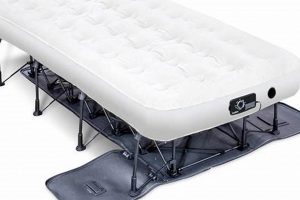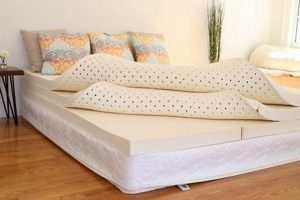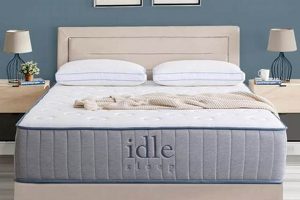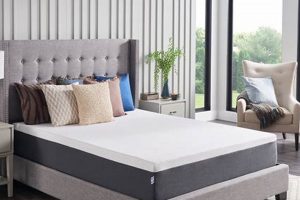Selecting a mattress that alleviates discomfort associated with sciatica is crucial for individuals experiencing this condition. The appropriate sleeping surface can significantly reduce pressure on the sciatic nerve, leading to improved sleep quality and diminished pain levels. The ideal choice provides both support and cushioning, facilitating proper spinal alignment and minimizing nerve compression during rest.
A mattress designed to address sciatic pain can contribute substantially to an individual’s overall well-being. By promoting a more comfortable and restorative sleep cycle, it aids in muscle relaxation and reduces inflammation around the sciatic nerve. Historically, individuals suffering from sciatica have sought various remedies, including specialized mattresses, to manage their symptoms and enhance their daily functionality.
The following sections will explore the key factors to consider when choosing a mattress to mitigate sciatic pain, including material types, firmness levels, and optimal sleeping positions. Understanding these aspects is essential for making an informed decision and achieving maximum relief.
Recommendations for Mattress Selection to Address Sciatic Discomfort
This section provides guidance on selecting a mattress that can help alleviate sciatic pain. The objective is to offer practical advice based on mattress features and their impact on spinal alignment and nerve compression.
Tip 1: Prioritize Spinal Alignment: A mattress should maintain the natural curvature of the spine. Test mattresses in various sleeping positions to ensure proper alignment is achieved, particularly in the lumbar region.
Tip 2: Consider Medium-Firm Support: Mattresses with medium-firm support typically offer a balance between comfort and spinal stabilization. This firmness level prevents excessive sinking, which can exacerbate sciatic nerve compression.
Tip 3: Evaluate Material Composition: Memory foam, latex, and hybrid mattresses are often recommended due to their contouring properties and pressure relief capabilities. Research the specific characteristics of each material to determine suitability.
Tip 4: Assess Pressure Relief: Pay attention to how the mattress distributes body weight. Even pressure distribution minimizes pressure points along the spine and hips, reducing the likelihood of sciatic nerve irritation.
Tip 5: Research Edge Support: Strong edge support allows for unrestricted movement and prevents the feeling of rolling off the mattress. This is especially beneficial for individuals who frequently change positions during sleep.
Tip 6: Trial Period Utilization: Take advantage of trial periods offered by mattress retailers. This allows for an extended assessment of the mattress’s impact on sciatic pain and overall comfort.
Tip 7: Consult Healthcare Professionals: Seek guidance from a physician or physical therapist regarding mattress selection. Professional recommendations can be tailored to specific spinal conditions and individual needs.
Adhering to these guidelines can assist individuals in identifying a mattress that promotes spinal health and minimizes sciatic pain, leading to improved sleep and reduced discomfort.
The subsequent section will provide a summary of the article and its main recommendations for individuals seeking relief from sciatic pain through appropriate mattress selection.
1. Spinal Alignment
Spinal alignment is a critical factor when selecting a mattress aimed at alleviating sciatic pain. Misalignment of the spine can exacerbate sciatic nerve compression, leading to increased discomfort and impaired sleep. A mattress that supports the natural curvature of the spine promotes optimal alignment, reducing pressure on the sciatic nerve roots and mitigating pain symptoms. For instance, a person sleeping on a mattress that allows their hips to sink too deeply can experience increased pressure on the lower back and subsequent nerve irritation.
The significance of spinal alignment extends beyond immediate pain relief. Prolonged periods of spinal misalignment can contribute to chronic back problems and perpetuate sciatic pain cycles. Therefore, a mattress capable of maintaining proper spinal posture is not only beneficial for immediate comfort but also for long-term spinal health. Consider the example of side sleepers; they require a mattress that conforms to the contours of their body while keeping the spine level. Without adequate support, the upper hip can drop, creating spinal curvature and stressing the sciatic nerve.
In conclusion, achieving and maintaining spinal alignment during sleep is a fundamental aspect of addressing sciatic pain through mattress selection. The ability of a mattress to provide adequate support, conforming to the individual’s body shape and sleeping position, directly impacts the degree of pressure exerted on the sciatic nerve. Prioritizing spinal alignment is a key step towards reducing pain and improving overall sleep quality for those suffering from sciatica. Overlooking this vital element can negate other benefits a mattress may offer.
2. Pressure Relief
Pressure relief is a critical determinant when assessing the suitability of a mattress for individuals experiencing sciatic pain. Elevated pressure on specific body points can exacerbate nerve compression, intensifying pain and disrupting sleep. The ability of a mattress to distribute body weight evenly minimizes concentrated pressure, fostering an environment conducive to nerve decompression and subsequent pain reduction. For example, a mattress that fails to adequately contour to the hips and shoulders of a side sleeper will create focal points of pressure, potentially aggravating sciatic nerve irritation.
The connection between pressure relief and sciatic pain extends to various sleeping positions. Individuals who sleep on their back may experience pressure points along the sacrum and lumbar region, contributing to nerve compression. Similarly, stomach sleepers can encounter pressure around the hips and rib cage, further exacerbating pain symptoms. A mattress with effective pressure-relieving properties, such as those incorporating memory foam or latex, can adapt to these varying pressure zones, promoting a more comfortable and less disruptive sleep experience. The objective is to create a sleeping surface that conforms to the body’s unique contours, ensuring that weight is distributed across a wider area, thus diminishing localized pressure.
In summary, pressure relief constitutes a fundamental element in selecting a mattress aimed at mitigating sciatic pain. The capacity of a mattress to evenly distribute body weight and alleviate localized pressure directly influences the degree of nerve compression experienced during sleep. Overlooking this aspect can negate other supportive features of the mattress, potentiall
y leading to continued pain and discomfort. Therefore, prioritizing pressure relief is a vital step towards achieving a more restful and pain-free sleep for those suffering from sciatica. The ideal mattress effectively minimizes pressure points, fostering an environment that supports nerve decompression and reduces pain symptoms.
3. Firmness Level
Firmness level directly influences a mattress’s ability to alleviate sciatic pain. The ideal firmness provides adequate support to maintain spinal alignment while simultaneously offering sufficient cushioning to minimize pressure points. A mattress that is too soft may not provide enough support, allowing the spine to sag and potentially compress the sciatic nerve. Conversely, a mattress that is too firm may not conform to the body’s contours, resulting in increased pressure on bony prominences like the hips and shoulders, which can aggravate sciatica. For instance, an individual with sciatica who sleeps on a very soft mattress might experience increased lower back pain due to spinal misalignment during the night.
Determining the appropriate firmness level is subjective and depends on factors such as body weight, sleeping position, and individual preferences. Generally, individuals with sciatica find that a medium-firm mattress offers the most effective balance. This firmness level allows the spine to maintain its natural curvature, promoting proper alignment and reducing pressure on the sciatic nerve. Side sleepers, in particular, often benefit from a medium-firm mattress that conforms to the body’s contours while providing adequate support to prevent spinal misalignment. As an example, a heavier individual may require a firmer mattress to prevent excessive sinking, whereas a lighter individual may prefer a slightly softer mattress for enhanced comfort and pressure relief.
In conclusion, firmness level plays a crucial role in selecting a mattress that can effectively alleviate sciatic pain. The correct firmness supports spinal alignment, minimizes pressure points, and accommodates individual needs. A balance between support and comfort is essential to reduce nerve compression and promote restful sleep. The practical significance of understanding the relationship between firmness level and sciatic pain lies in enabling individuals to make informed mattress choices that can significantly improve their comfort and overall well-being. While the best choice remains subjective, considering spinal alignment and pressure relief as the primary goal is critical.
4. Material Composition
Material composition constitutes a primary determinant in the effectiveness of a mattress designed to alleviate sciatic pain. The materials used directly influence pressure distribution, spinal support, and overall comfort, thereby impacting the degree of sciatic nerve compression. Selecting a mattress with appropriate materials is crucial for managing sciatic pain.
- Memory Foam
Memory foam conforms closely to the body, distributing weight evenly and reducing pressure points. Its viscoelastic properties allow it to respond to body heat and weight, molding to the individual’s contours. In the context of sciatic pain, memory foam can minimize pressure on the sciatic nerve by providing targeted support and cushioning. However, some memory foam mattresses can retain heat, potentially causing discomfort. For example, a memory foam mattress with an open-cell structure promotes better airflow and reduces heat retention, enhancing comfort for individuals with sciatica.
- Latex
Latex offers a balance of support and pressure relief, making it a viable option for those seeking a mattress to alleviate sciatic pain. Natural latex is derived from rubber trees and is known for its durability and resilience. It provides a responsive surface that contours to the body while maintaining spinal alignment. Unlike memory foam, latex tends to sleep cooler, minimizing heat retention. For instance, a Dunlop latex mattress is denser and provides firmer support, whereas a Talalay latex mattress is softer and more responsive, allowing for customized comfort levels to accommodate differing degrees of sciatic pain.
- Hybrid (Coil and Foam)
Hybrid mattresses combine the support of innerspring coils with the comfort of foam layers, offering a balanced approach to addressing sciatic pain. The coil system provides structural support and airflow, while the foam layers deliver pressure relief and contouring. The specific combination of coil type and foam density determines the overall firmness and support level. As an example, a hybrid mattress with pocketed coils minimizes motion transfer and provides targeted support, while a combination of memory foam and latex in the comfort layers can enhance pressure relief and spinal alignment, catering to the specific needs of individuals with sciatica.
- Support Core (Innerspring or Foam)
The support core of a mattress, whether composed of innerspring coils or dense foam, significantly impacts spinal alignment and overall support. Innerspring systems offer varying levels of firmness and responsiveness, depending on coil gauge and construction. Foam cores, particularly high-density polyurethane foam, provide a stable and supportive base. For example, a mattress with a zoned coil system can offer targeted support to different areas of the body, ensuring proper spinal alignment and minimizing sciatic nerve compression. Similarly, a high-density foam core prevents sagging and maintains consistent support over time, contributing to long-term relief from sciatic pain.
The selection of mattress materials should be guided by a comprehensive understanding of their individual properties and how they contribute to spinal support, pressure relief, and overall comfort. Different materials interact uniquely to influence the sleeping experience, highlighting the need for careful consideration when choosing a mattress aimed at minimizing sciatic pain.
5. Support System
The support system within a mattress significantly impacts its ability to alleviate sciatic pain. The primary function of the support system is to maintain spinal alignment and provide stable resistance against body weight, preventing excessive sinking that can exacerbate nerve compression. The effectiveness of the support system directly correlates to the overall comfort and pain reduction experienced by individuals with sciatica. A weak or inadequate support system can lead to spinal misalignment, increased pressure on the sciatic nerve, and subsequent pain amplification. For example, a mattress with worn-out or low-quality coils may sag in the center, causing the spine to curve unnaturally during sleep, thereby worsening sciatic symptoms.
Various types of support systems are employed in mattresses designed for sciatic pain relief. Innerspring systems, with their interconnected or individually wrapped coils, offer varying degrees of firmness and responsiveness. Individually wrapped (pocketed) coils, in particular, excel at minimizing motion transfer and providing targeted support to different areas of the body. Foam cores, often constructed from high-density polyurethane foam, offer a more uniform and
consistent support base. Hybrid mattresses combine these approaches, integrating the benefits of both coil and foam support. For instance, a hybrid mattress with a pocketed coil system and a high-density foam encasement can provide excellent spinal support while simultaneously reducing motion transfer and enhancing edge support, all of which contribute to a more comfortable and pain-free sleep experience.
In summary, the support system is a fundamental element in determining the suitability of a mattress for individuals seeking relief from sciatic pain. A well-designed support system maintains spinal alignment, distributes weight evenly, and prevents sagging, all of which are essential for minimizing nerve compression and promoting restful sleep. Understanding the characteristics and benefits of different support system types empowers individuals to make informed decisions that can significantly improve their comfort and overall well-being. The selection of an appropriate support system is, therefore, a critical step in choosing a mattress optimized for addressing sciatic discomfort and related sleep disturbances.
Frequently Asked Questions About Mattresses for Sciatic Pain
This section addresses common inquiries regarding mattress selection for managing sciatic pain. The objective is to provide clear and informative answers to aid in making well-informed purchasing decisions.
Question 1: How does a mattress contribute to sciatic pain relief?
A mattress designed to alleviate sciatic pain provides adequate spinal support, maintaining proper alignment and minimizing pressure on the sciatic nerve. Effective pressure distribution reduces nerve compression, leading to diminished pain levels.
Question 2: What mattress firmness is most suitable for individuals with sciatica?
A medium-firm mattress is often recommended. This firmness level offers a balance between support and comfort, preventing excessive sinking and maintaining spinal alignment without creating undue pressure points.
Question 3: Which mattress materials are preferred for sciatic pain management?
Memory foam and latex are frequently recommended due to their contouring properties and pressure relief capabilities. Hybrid mattresses, combining coils and foam, can also provide effective support and comfort.
Question 4: How important is spinal alignment in mattress selection for sciatica?
Spinal alignment is crucial. A mattress should support the natural curvature of the spine, preventing misalignment and reducing pressure on the sciatic nerve. Testing mattresses in various sleeping positions is essential to ensure proper alignment.
Question 5: Can an old mattress exacerbate sciatic pain?
Yes. Over time, mattresses lose their support and cushioning, leading to spinal misalignment and increased pressure points. Replacing an old mattress can significantly improve comfort and reduce sciatic pain.
Question 6: Should a healthcare professional be consulted regarding mattress selection for sciatica?
Consultation with a physician or physical therapist is advisable. Healthcare professionals can provide personalized recommendations based on specific spinal conditions and individual needs.
Key takeaway: Selecting a mattress tailored to individual needs, with careful consideration of firmness, material, and spinal alignment, is paramount for effectively managing sciatic pain.
The following section summarizes the core recommendations for mattress selection aimed at alleviating sciatic pain.
Best Mattress for Sciatic Pain
The preceding exploration has emphasized the critical role of mattress selection in managing sciatic pain. Key considerations, including spinal alignment, pressure relief, firmness level, material composition, and support system design, directly influence the degree of nerve compression and subsequent discomfort experienced. Optimal mattress selection, guided by these principles, can significantly enhance sleep quality and reduce sciatic symptoms.
The selection of the best mattress for sciatic pain requires careful assessment and a comprehensive understanding of individual needs. Continued awareness of mattress technology and its impact on spinal health remains essential for those seeking effective, long-term relief. Prioritizing this investment in sleep health can improve overall well-being and alleviate the challenges associated with sciatica.







![Top-Rated: Best Foam Mattress for Camping - [Year] Guide Organic & Natural Mattress Buyer’s Guide: Non-Toxic Sleep Solutions Top-Rated: Best Foam Mattress for Camping - [Year] Guide | Organic & Natural Mattress Buyer’s Guide: Non-Toxic Sleep Solutions](https://mattressworldpa.com/wp-content/uploads/2025/07/th-7661-300x200.jpg)